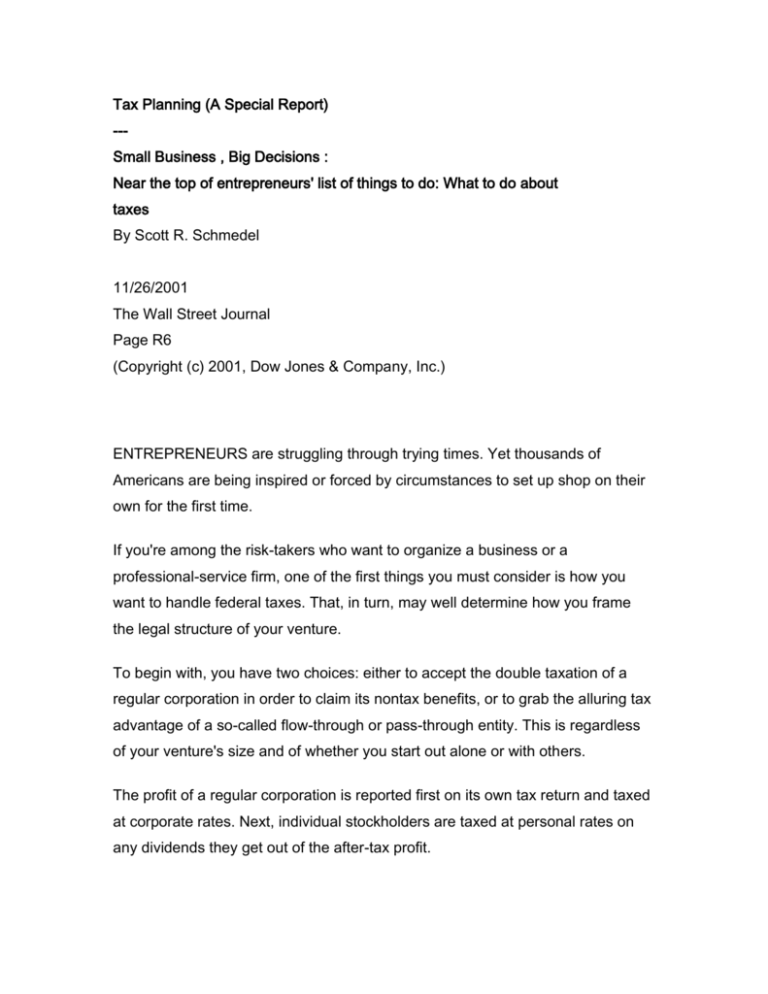Tax Planning
advertisement

Tax Planning (A Special Report) --Small Business , Big Decisions : Near the top of entrepreneurs' list of things to do: What to do about taxes By Scott R. Schmedel 11/26/2001 The Wall Street Journal Page R6 (Copyright (c) 2001, Dow Jones & Company, Inc.) ENTREPRENEURS are struggling through trying times. Yet thousands of Americans are being inspired or forced by circumstances to set up shop on their own for the first time. If you're among the risk-takers who want to organize a business or a professional-service firm, one of the first things you must consider is how you want to handle federal taxes. That, in turn, may well determine how you frame the legal structure of your venture. To begin with, you have two choices: either to accept the double taxation of a regular corporation in order to claim its nontax benefits, or to grab the alluring tax advantage of a so-called flow-through or pass-through entity. This is regardless of your venture's size and of whether you start out alone or with others. The profit of a regular corporation is reported first on its own tax return and taxed at corporate rates. Next, individual stockholders are taxed at personal rates on any dividends they get out of the after-tax profit. However, the earnings of a flow-through concern are taxed at just one level. The business doesn't pay taxes. Instead, all of its profit (including income retained in the business) or loss generally "flows through" to the owners. Then individuals report their apportioned shares of the results on documents attached to their personal returns, to be taxed at their personal rates. There are four main types of flow-through to choose from (remember them for the midterm exam). They are the sole proprietorship for one owner, which is the simplest form; the partnership; the S corporation, which is taxed much like a partnership and is named for the Internal Revenue Code subchapter that covers it; and the limited-liability company, or LLC. Each of these entities has its pros and cons, tax and nontax. However, according to tax advisers, the relatively new LLC has rapidly become the preferred structure for flow-through enterprises, thanks to federal-tax and other enhancements gained in the 1990s. "Generally, people start by using some form of flow-through entity," says David A. Lifson, managing partner of the New York City accounting firm Hays & Co. For one thing, the business losses that tend to come during the early days pass through to the owners to offset taxes on their other income. Moreover, he says, "there's no tax cost associated with turning a flow-through into a regular corporation later on, but transforming a corporation into a flow-through is a taxable transaction." Flow-throughs have two principal tax negatives, notes Mr. Lifson, who is a director of the American Institute of Certified Public Accountants and a former chairman of its tax executive committee. First, the top personal income-tax rate is higher currently than the corporate rate. That drawback may be offset by the fact that the sale of a corporation can lead to taxes on both the company's and the owners' gains, while only the owners of a flow-through may be taxed on its sale, he says. Under the 2001 tax act, the highest individual tax rate is scheduled to drop from 39.1% in 2001 to 35% in 2006, equaling the top corporate rate. In the long term that should make flow-throughs more attractive, provided that Congress doesn't reshuffle rates during the next five years. An often more troublesome disadvantage relates to the sale of a flow-through, Mr. Lifson continues: A regular corporation can be sold or merged into another corporation with a tax-free exchange of stock, but a flow-through can't. Whichever form you choose, make sure that you have "a firm understanding" of all of its obligations regarding taxes, business liabilities and other matters, cautions Robert Hunt, of the Internal Revenue Service. He is deputy director of Taxpayer Education and Communication for the IRS's Small Business/SelfEmployed division. His unit's tax workshops offer what he describes as "preventive information" to people who have small businesses or are planning to start them. You certainly must consider many factors besides taxes in choosing a form for your business. They include personal protection against business liabilities, the number of owners and investors, a need to raise capital, and long-term goals. Any of them may be far more decisive than taxes in your choice and may well channel you into a regular corporation despite its double taxation. Remember that state laws, not federal, govern the formation and operation of all business structures. Those statutes vary from state to state, so you should consult an adviser about the tax pros and cons of each form in your state and how they weigh on the other considerations. You may also take advantage of instruction from the IRS, the Small Business Administration, and other sources. Now, let's take a closer look at these business structures. SOLE PROPRIETORSHIP As a single owner, you face no formalities or costs to start and run this entity, unless your state or county requires a business or professional license. It's almost ideal for an operator who has no employees or only a handful, or who has become a consultant temporarily while looking for a job, or who has a part-time sideline. The federal tax treatment is simple. Your business doesn't even file a return. You report everything on Schedule C, Profit or Loss From Business, attached to your personal Form 1040 return. About 17.4 million taxpayers filed Schedule Cs for 1998, the IRS says; more than 250,000 of them reported receipts exceeding $500,000. Consider an electrician with three employees who is a client of Nancy E. Goedecke, of Hudson, Mass., an enrolled agent (a tax specialist recognized by the IRS). The electrician has reported receipts and all expenses on Schedule C for more than 15 years. Attachments cover self-employment taxes (Social Security and Medicare), a home office and depreciation of business assets. A retailer would have to add an inventory form, Mrs. Goedecke notes. The electrician also pays quarterly estimated taxes and uses a payroll service to deal with employee-payroll taxes. The big disadvantage of both sole proprietorships and partnerships is that the owners are liable personally for all obligations and risks arising from the business. Liability protection is the main reason entrepreneurs form corporations or LLCs. That way, they limit their potential loss generally to their investments in the business. But sole proprietors and partners can protect their homes and other personal assets with insurance against a variety of business risks, Mrs. Goedecke says. For example, as a sole proprietor herself, she includes errors-and-omissions insurance among her policies. PARTNERSHIP For two or more owners, a partnership is also relatively easy to set up. There are some formalities, though, and there is the cost of hiring a lawyer to draw up a comprehensive partnership agreement. Although the partnership itself doesn't pay tax, it must file a federal informational return, Form 1065, and send a Schedule K-1 statement to each partner. The K-1 provides the information needed for partners to prepare Part II of Schedule E, Supplemental Income and Loss, for attachment to their personal 1040s. Nearly 1.9 million partnerships with nearly 15.7 million partners filed 1065s for 1998, the IRS says. REGULAR, OR C, CORPORATION Liability protection isn't the only compelling reason to adopt the "C" form, socalled for its chapter in the tax code. You can sell stock to raise capital, and stock is easy to transfer from one owner to another. And then there's the matter of image: Some investors, lenders, customers and suppliers may prefer to deal with a corporation because it seems better organized and more substantial. Furthermore, says Mr. Lifson, the New York CPA, "I've had clients who started, say, biotech companies with the goal of going public or selling out to a big corporation in a tax-free, stock-for-stock exchange. They formed corporations." Certain professionals, such as doctors, lawyers and accountants, may form professional corporations, which have special requirements. Setting up a corporation can be relatively costly and complicated. States require a number of annual document filings and fees, plus actions such as formal directors' meetings. Preparing the tax return, Form 1120, can be expensive. Dissolving a corporation raises significant tax issues that you should consider before you form one. S CORPORATION This structure was developed as a means of combining limited liability and the other main benefits of a corporation with the flow-through tax break of a partnership. Starting in the late 1980s, the number of S corporations grew rapidly. The IRS received nearly 2.6 million Form 1120S informational returns from them for 1998. But this entity is subject to several restrictions, including one limiting personal deductions of its losses, and to a maximum of 75 stockholders. The formalities and cost of setting up an S corporation are about the same as those for a regular corporation. As for taxes, the company sends K-1 statements to stockholders; and they report pro-rata results on Schedule E, Part II, attached to their 1040s. LIMITED-LIABILITY COMPANY These days, "substantially all" new pass-through businesses are formed as LLCs rather than partnerships or S corporations, says Joe Huddleston, of Nashville, Tenn., a former Tennessee revenue commissioner who is national managing partner for state and local taxes at the CPA firm Grant Thornton. Although Wyoming adopted the first LLC statute in 1977 to create a hybrid entity with both partnership attributes and limited liability, the form languished because the IRS long considered many LLCs to be corporations in sheep's clothing. That position gradually softened, and liberal regulations that took effect in 1997 started the boom. Under these "check-the-box regs," the IRS treats single-owner LLCs automatically as sole proprietorships and multiple-owner companies as partnerships, unless they elect treatment as corporations. LLC owners who operate as sole proprietors or partners follow the federal tax rules for those forms. The states' tax treatment of LLCs varies; ask about taxes in your state. All states and the District of Columbia now provide LLCs with flexible financial and management rules. While the recently adopted or rewritten state statutes aren't uniform, they generally are far more accommodating to owners and less restrictive than the laws governing other pass-throughs. As a result, "the viability of the S corporation and the partnership has declined dramatically," Mr. Huddleston says. (However, current data about the number of new formations isn't available yet.) A related form available in most states is the limited-liability partnership, designed especially for professionals such as accountants, lawyers and doctors. Forming and maintaining an LLC or LLP may require more state administrative filings and expense than for other pass-throughs. LLCs are so new that one concern about them is the lack of a broad judicial history, notes Mark Luscombe, CPA, lawyer and principal analyst for federal and state taxes at publisher CCH Inc., Riverwoods, Ill. That is, the state statues haven't been tested thoroughly in litigation, in order to settle possible major issues regarding liability protection and other matters. However, that hasn't seemed to put a hold on new LLCs. It's also important to learn all the ramifications of operating an LLC across state borders, because of statute variations, Mr. Luscombe says. But, listen to this: Tax advisers say more and more LLCs are being formed in Delaware by out-ofstate operators, because that state's laws for LLCs -- like its laws for corporations -- are said to be the most flexible. --Mr. Schmedel is a writer in Mountainside, N.J. ---




